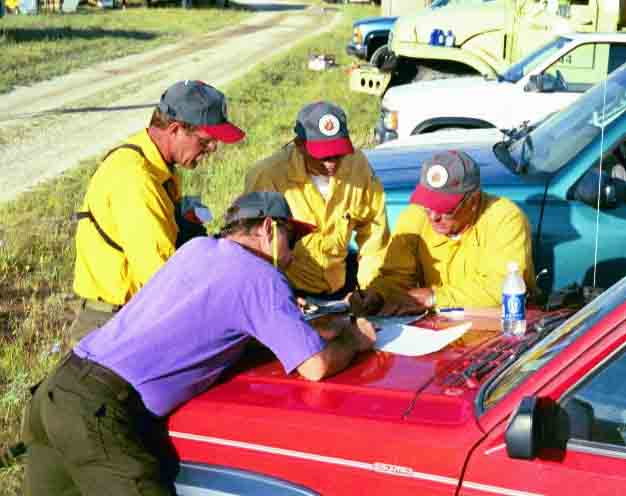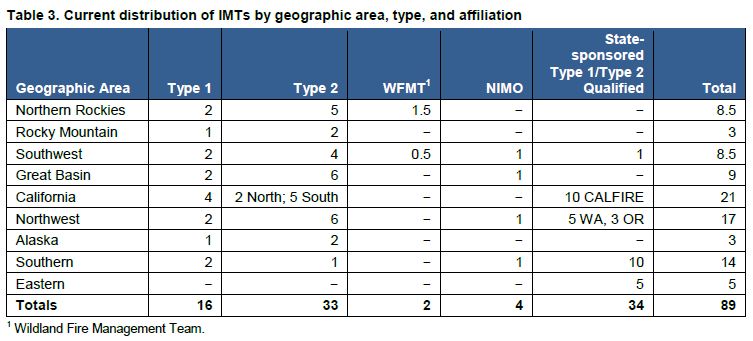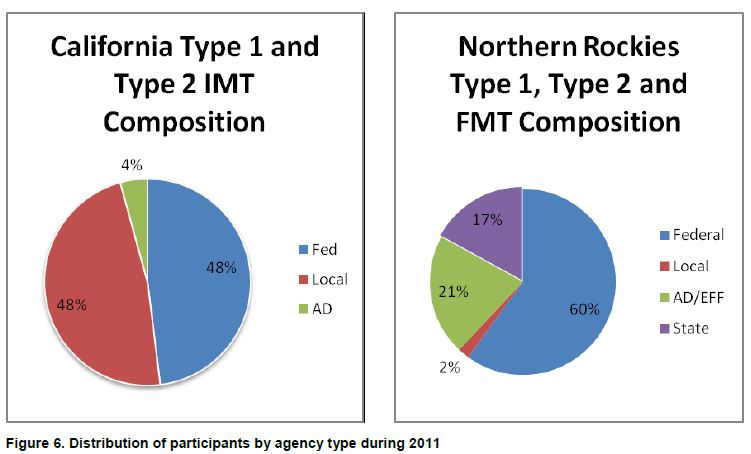
The National Wildfire Coordinating Group (NWCG) has released a new organizational model for Incident Management Teams (IMT), titled Evolving Incident Management: A Recommendation for the Future.
(Apparently they decided not to make a recommendation for the past.)
In light of smaller federal work forces, more state and local IMTs, and longer fire seasons, the NWCG recognized that the current workforce management and succession planning for wildfire response is not sustainable. The new plan, which refers to a “decrease in Federal capacity”, admits that one of the primary purposes of the new model is to help find a solution to the difficulty in filling positions on IMTs, in part due to the smaller work forces. This, in spite of the fact that the U.S. Forest Service routinely assures congressional panels and the public that the federal government has plenty of wildland fire suppression capability and the budgets proposed by the Administration for the land management agencies are sufficient for protecting the public lands.
Some of the recommended changes are very significant, such as combining the Type 1 and Type 2 IMTs into just one type of team, and reducing the total number of federally sponsored teams from 55 to 40.
The entire 51-page document can be found HERE. Below, in the bullets, are some of the highlights of the new system:
- Number of Teams. The target number of federally sponsored IMTs is 40.
- Typing of Teams. Merge all federally sponsored type 1 and type 2 teams into one type of IMT.
- NIMO teams.There [would continue to] be four National Incident Management Organization (NIMO) teams supervised and managed by the USDA Forest Service.
- Incident Complexity and Scalability. There are three response levels: Initial attack (type 4 and 5 incidents), extended attack (type 3 incidents managed by type 3 IMTs) and complex incidents managed by IMTs.
- State teams. IMTs sponsored by states would provide surge capacity at elevated geographic area and national preparedness levels under the recommended model.
- Team Management and Dispatching. Geographic area coordination centers would manage IMT rotations for their geographic area until the national preparedness level reaches 3. At preparedness level 3 and above the National Interagency Coordination Center coordinates the IMT rotation in consultation with the geographic area coordination centers.
- Team Funding. Each IMT would receive an established amount of support funding provided by the agencies in their home geographic area. Teams are provided with administrative staff support to support ICs with management of their team rosters and other logistical needs.
- Team Size and Configuration. IMTs are composed of 27 members and 14 trainees in the recommended organizational model. The IMTs are available in short team and long team configurations.
- Area Command. Short-term recommendations (2012–2015) include (1) maintaining four area command teams, and (2) formalizing the current management of the four area command teams as a pool of interchangeable personnel sufficient to staff four teams. Long-term recommendations (2016 and beyond) include transitioning area command teams to strategic management teams. This would more accurately reflect the changing demands for an oversight group to provide strategic planning, risk management, command, control, coordination, information management, and preparedness support. This transition would also be the source for innovative processes, procedures, and technology to support incident objectives.
- Performance and Accountability. All agency administrators in units with wildland fire programs would have a performance standard or element for fire management. Expectations for each agency’s level of participation should be developed based on their percent of wildland fire workload.
- Incentives. Incentives for participation should be a part of the implementation plan for the recommended organizational model. Disincentives should be identified and reduced or eliminated.
- Workforce Development. Develop a robust and coordinated succession planning system linking workforce development to staffing of IMTs.
The NWCG expects to implement the new model over the next five to ten years.
Several interesting facts showed up in the document, such as on page 22:
Although the number of IMTs has remained relatively stable since 2004, the composition of teams has changed. The Federal workforce has shrunk, especially in some parts of the country. For example, the USDA Forest Service workforce in Oregon and Washington has gone from 7,893 employees in 1990 to 3,630 employees in 2010. IMT make-up has shifted from Federal militia to a higher percentage of state, local government, and retired Federal (second career and AD) participation.
And these three charts:
The group that put together the analysis and recommendations was called the Incident Management Organizational Succession Planning Team (IMOSPT). The Liaison with the NWCG was Lyle Carlile of the Bureau of Indian Affairs. The “Project Team” consisted of:
- Sue Husari, Chair, National Park Service
- Este Stifel, Bureau of Land Management
- Jim Peña, Forest Service
- Pete Anderson, National Association of State Foresters, Nevada
- Rex McKnight, Bureau of Land Management
- Tom Zimmerman, Forest Service
Other groups within the IMOSPT included Team Typing and Configuration, Incident Business and Staffing Team, Training Team, a Communications Liaison, and Communications and Project Support.




Safety issues?
Time for the IMT’s to start training and crosstraining for all risk environments.
Is not that desire of the land management agencies? After all, they were qualified to do all these all risk all hazard ops after the Challenger incident and Katrina!
Time for the tried and true IMT’s to start accepting the folks who have the desire and moxie to be on an IMT.
I agree, strip the H pay and then see who steps up to the plate. The expense of IMT’s has gotten somewhat out of hand and was not there a BIG STUDY back in 2006-2008 on WHY these were so expensive? Feds might start need to teach the States EM’s and land management how this works ‘cuz it is their balliwick when State and private lands abute Fed lands and those folks…alll they get is OT or Comp time if they are FSLA professionals, NO H pay!!!
Better start training a cadre for the future…..like all the cries I hear in aviation……..there are way too many retiring pilots and mechanics and …..whaaaaaa…..no replacements or folks who are interested in doing this type of work….
IMT’s are not exempt in this arena or theatre, either. UNLESS the retiring GS’s are willing… oh wait…they are!!!…. becoming AD’s with those high THSP pay scales!!!
As a past FS fire and fuels manager, I can appreciate the spot they are in, however I hope they proceed with caution. So…….as the numbers of fires are going up, the proposal is to reduce and consolidate the numbers of IMT’s. This translates into more and longer deployments for individual teams and team members. It also appears that in order to meet the demand for teams and team members, training and experience will start to take a backseat, at a time when WUI fires are increasing in numbers and complexity. This will translate into safety issues. 🙂
A large part of the succession managment problem is agencies, both fed and state, have leaned toward becoming land management based as opposed to being natural resource protection. All position descriptions should include “WILL participate in fire prevention/suppression activities” Weed out equaly qualified candidates by the one’s who show an intrest in becoming part of the militia. We have too many folks on the public teat that only want to do the bare minimum to get their job done.
Remove portal to portal pay, hazard pay and move to a small hourly rate bump while participating in organized fire management activities. I understand that portal to portal pay has been bargained for in R5. Dont use them on federal incidents as i as a tax payer from out of region has to pay for. If California want to pay portal to portal then they can use those folks on California State incidents only. Why do you think Oregon doesn’t use Calfire FF’s on their state incidents? We dont want to pay for them. Nothing personal…
Bottom line is that their is not that much differance in type 1 and 2 incidents that staffing appropriatly couldn’t overcome. We dont need that many teams, just teams that staff fires correctly.
What will it take to bring all of the people on the Type II teams up to an Type I level?
Or, bring the Type 1 folks down to the Type 2 level?
Good question, Robert. The document addresses the issue in three places. Here are some quotes:
—“Eliminate distinctions between type 1 and type 2 qualifications for command and general staff and transition to one type of federally sponsored IMT.”
—“Review the PMS 310-1 Wildland Fire Qualifications System Guide and make training and experience adjustments for the new IMT model.”
—“Review and streamline qualification requirements in PMS 310-1 Wildland Fire Qualifications System, USDA Forest Service 5109.17 manual, and other agency policies.”